|
The 11th edition of the biennial aerospace extravaganza,
which ran for five days from Nov 15 to 19, attracted
52,978 industry professionals from 138 countries.
This is an 18 per cent rise in attendee numbers
compared to the previous airshow when 45,421 industry-linked
visitors from 131 countries logged the event.
The increased visitor turnout, at a time when
the international aerospace industry is reeling
under the impact of a global downturn, confirmed
that the Middle East region is the springboard
for a rebounding aerospace industry, organizers
F&E Aerospace claimed.
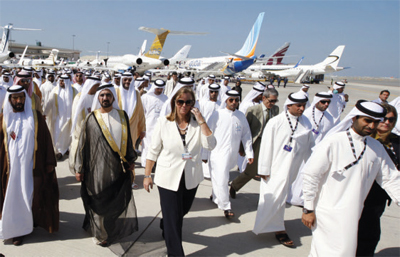 However,
reflecting the global economic meltdown, new aircraft
orders announced at the show were only a fraction
of the record orders registered at the previous
edition. However,
reflecting the global economic meltdown, new aircraft
orders announced at the show were only a fraction
of the record orders registered at the previous
edition.
This year, the declared onsite order book was
valued at $14 billion compared to more than $100
billion registered at the show in 2007. This year’s
total order book comprises sales of civil and
military aircraft, helicopters, engines, plus
agreements for heavy maintenance, cabin refurbishment
and crew management processes.
“New participants came from the UAE, Saudi Arabia,
the UK and USA and covered a range of activities
from training simulators, to the world’s first
planned supersonic business jet, from VIP and
specialised aircraft services to suppliers of
ejector seats and unmanned aerial vehicles. The
scale and scope of opportunity was hugely diverse
and the prevailing sentiment on the exhibition
floor was one of business innovation,” said Alison
Weller, Director of F&E Aerospace.
A highlight of the show’s new blood was the L-15
Falcon advanced jet trainer from China’s AVIC
which made its international aerospace exhibition
debut.
The increase in visitors was reflected in the
show’s biggestever exhibitor numbers - 890 companies
from 47 countries, with 150 first-time participants
– plus an additional 7,000sqm in floor space to
accommodate the anticipated surge in exhibitors,
as the eyes of the aerospace industry turned to
the Middle East region for signs of an upturn.
Organisers said a significant number of companies
had already signed up to the next Dubai Airshow
at Airport Expo, Dubai, from 30 October to 3 November
2011, taking advantage of the price freeze on
exhibitor space which continues until the end
of 2010.
In many ways Dubai Airshow 2009 had already defied
the odds. Exhibitors spanned four halls, including
the new 7,000 square metre temporary Emirates
Hall, while 130 aircraft, an intriguing mix of
next-generation passenger airlines, the most luxurious
of VIP jets and military air might filled the
static park, including the newest and most advanced
US fighter jet, the F-22 Raptor.
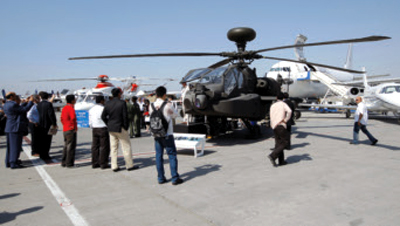 It
was a pervading sense that this show perhaps more
than any other, being the Middle East’s foremost
aerospace event and the world’s fastest growing,
could witness a revival in aerospace industry
fortunes that attracted a record turnout of a
powerful, and influential, 800-plus international
media corps. It
was a pervading sense that this show perhaps more
than any other, being the Middle East’s foremost
aerospace event and the world’s fastest growing,
could witness a revival in aerospace industry
fortunes that attracted a record turnout of a
powerful, and influential, 800-plus international
media corps.
And their anticipation was backed up by His Highness
Sheikh Ahmed Bin Saeed Al Maktoum, President,
Dubai Department of Civil Aviation and Chairman
of Dubai Airports, who sounded a rallying call
as the show opened, clearly positioning the UAE
at the forefront of the expected upturn.
“We are open to ideas: we are ready to work with
companies in partnership,” he said in his welcome
address, going on to describe the show as timely
and on the cusp of a business upturn.
“It is the Middle East – and the GCC in particular
– that has seen a growth in air transport, while
elsewhere there have been falling passenger numbers.
It is in the Gulf that we have seen launch customer
deliveries of some of the finest business jets.
It is Middle Eastern carriers that have been leading
the way with the introduction of new cabin and
in-flight communication technologies. It is also
in this region that we see the greatest investment
in ground infrastructure, such as airports and
air traffic management systems.”
Sheikh Ahmed added that the region’s, and most
notably the UAE’s, investment in sophisticated
defence systems is providing a secure landscape
and delivering reassurance to investors.
And the aerospace audience was not to be disappointed
as the show quickly proved to be a weathervane
for the aviation industry and a fertile platform
igniting cross-border business.
A joint show opening by Their Highnesses Sheikh
Mohammed Bin Rashid Al Maktoum, UAE Vice President
and Prime Minister and Ruler of Dubai and Sheikh
Mohammed Bin Zayed Al Nahyan, Crown Prince of
Abu Dhabi and Deputy Supreme Commander of the
UAE Armed Forces, prompted industry observers
to comment on the region’s changing industry dynamics.
 The
eve-of-show announcement by Abu Dhabi’s Mubadala
Development Company that it would open an advanced
composite aero structure manufacturing unit in
the emirate’s second city of Al Ain was seen as
a forerunner of things to come. The
eve-of-show announcement by Abu Dhabi’s Mubadala
Development Company that it would open an advanced
composite aero structure manufacturing unit in
the emirate’s second city of Al Ain was seen as
a forerunner of things to come.
The coming of age of an indigenous Arabian aerospace
industry brought a new dimension to industry players
– one which, according to visitor Ravi Darira
of India’s RaviRaj Process Control, many ancilliary
suppliers had failed to foresee.
“It is a good show but largely dominated by
the big ticket manufacturers. I came looking for
ancillary products and believe the ancillary suppliers
are missing a trick by not being here in greater
numbers,” he observed.
Said Willis J Brown, VP Business Development,
Alsalam Aircraft Company, Saudi Arabia: “The show
was flawless from an organisational point of view
and we were able to receive a Lebanese military
delegation to further talks with them which actually
began at the 2007 show. From an exhibitor point
of view, one of the great things about this show
is the ease of getting in and out.”
While the UAE accounted for the largest country
share it represented less than a third of the
overall tally at just over 17,000. The impressive
turnout included 511 civil and military delegations,
including Ministers of Defence, presidents and
CEOs of airlines and chairmen of civil aviation
authorities.
Members or ruling and royal families from throughout
the Gulf and Middle East featured strongly in
the delegation line-up – and throughout their
tours they gave valuable insights into their future
needs.
UAE Minister for Higher Education, Sheikh Nahyan
Bin Mubarak Al Nahyan, said a number of training
affiliations would result from his visit.
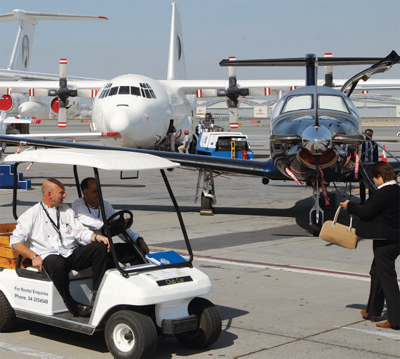 “A
highly trained and skilled cadre of technology
professionals is essential to our country as it
looks to build an indigenous aerospace industry,”
he said adding: “We are having talks at the show
to progress training affiliations and which will
definitely result in collaboration agreements.
This, of course, is necessary as the UAE steadily
progresses its own solid human resource infrastructure
of aviation and aerospace professionals.” “A
highly trained and skilled cadre of technology
professionals is essential to our country as it
looks to build an indigenous aerospace industry,”
he said adding: “We are having talks at the show
to progress training affiliations and which will
definitely result in collaboration agreements.
This, of course, is necessary as the UAE steadily
progresses its own solid human resource infrastructure
of aviation and aerospace professionals.”
The result was a declared onsite order book in
excess of US$14 billion, covering sales of civil
airliners and military trainers, helicopters,
aircraft engines, in- flight systems, simulators,
wheels and brakes and petrol-driven helicopters,
as well as contracts covering heavy maintenance
agreements, crew management processes and cabin
refits.
Civilian order highlights included: Airbus deals
with Ethiopian, Nepal, Senegal and Yemenia airlines,
as well as the Swiss-based luxury charter jet
company Comlux and Air Austral; Rolls-Royce engine
contracts with Air China and Ethiopian Airlines;
a range of deals from Abu Dhabi’s Etihad Airways
worth US$750 million; JorAMCo heavy maintenance
wins from Tailwind Airlines and Thomas Cook; an
Oman Air order for five Embraer aircraft; Boeing
sales to two Algerian airlines and Sikorsky’s
sale of two S-76D helicopters to the UAE’s Falcon
Aviation Services.
DAE Capital took final day headlines with its
US$40 million order – one of a total US$1 billion
series the company placed at the show – this time
for wheels and carbon brakes for its planned Boeing
737 fleet. The order went to Messier- Bugatti
of France.
The UAE’s PERLA Aviation, buoyed by the sale
of three of its petrolpowered AK1-3 light aircraft
to customers in Pakistan, India and the UK, was
confident of follow-on show business.
“It has just been excellent for us with strong
interest from throughout the Middle East, Africa,
Europe and the USA,” said PERLA’s Tanya Rashenko.
“We are also negotiating an additional three sales
leads gained here which we hope to conclude in
the coming weeks”
The much-awaited military deals came late in
the show when the UAE GHQ announced orders for
two SAAB 340 early-warning aircraft and for 25
Pilatus basic training PC-21 aircraft. The deals
are being seen as a precursor of further defence
orders to come.
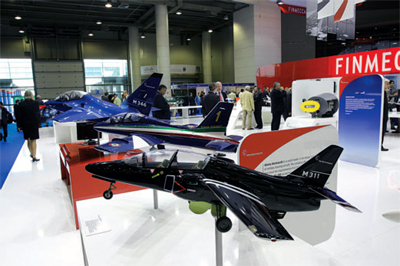 “The
UAE Air Force & Air Defence is currently evaluating
several options to purchase permanent solution
command and early-warning aircraft to meet the
UAE Armed Forces operational requirements,” an
official statement said. “The
UAE Air Force & Air Defence is currently evaluating
several options to purchase permanent solution
command and early-warning aircraft to meet the
UAE Armed Forces operational requirements,” an
official statement said.
Military alliances were also top of mind for
His Royal Highness Prince Feisal Bin Hussein,
Special Assistant to Jordan’s Joint Chief of Staff,
who confirmed he was at the show for talks of
“an undisclosed military nature.”
“I am here for three days to progress various
discussions I have been charged with and it has
been most useful having all the relevant companies
here at the show,” he said.
Deals at the show, though the signature headlines,
were underpinned by announcements which indicated
that the long-awaited industry upturn had arrived.
Dubai’s Emirates Group joined hands with the
Senegalese Government to support the carrier,
which is due to begin operations next year and
has a majority private sector shareholder base.
The Emirates Group will assist the airline in
both its start-up and post-launch phases with
commercial and technical expertise, training and
aviation-related goods and services.
The Middle East, while suffering some slowdown
from the global recession, has defied international
trends and continues to deliver exceptional growth
– a situation not lost on Boeing.
“We see tremendous growth for the Middle East
region, and Middle East carriers are well-positioned
to meet those growth requirements with the fleet
capacity they have in the form of unfilled orders,
or backlog,” said Randy Tinseth, Vice President
Marketing, Boeing Commercial Airplanes.
The US aircraft maker has forecast a requirement
among Middle East carriers for 1,710 new aircraft,
valued at US$300 billion over the next 20 years.
In terms of size, Boeing projects a Middle East
market for 970 twinaisle aircraft, expected to
account for around 50 per cent of the demand,
and a market for 680 single-aisle airplanes, around
40 per cent, with the remaining three per cent
being made up of demand for regional jets with
fewer than 90 seats.
And it may not be long before the demand is
converted into reality with visitors to the show
saying fleet assessments are under way.
Among them was Ali Al-Ghamdi, Manager Fleet Planning
of Saudi Arabian Airlines, bent on talks with
the key aircraft manufacturers.
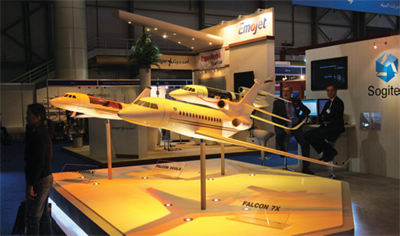 As
the show drew to a close, bookings for Dubai Airshow
in 2011 began with Mubadala Aerospace being the
first to sign up. Indications were also strong
that more new blood could be entering the profile,
as some visitors looked to convert their status
to exhibitors. As
the show drew to a close, bookings for Dubai Airshow
in 2011 began with Mubadala Aerospace being the
first to sign up. Indications were also strong
that more new blood could be entering the profile,
as some visitors looked to convert their status
to exhibitors.
“I came basically to asses the show, and the
market, as I have never been before,” explained
Mark Kelsey of Dunlop Aircraft Tyres of the UK.
“It has been extremely productive as we have found
new contacts and notice a trend here within the
airlines. Although they have smaller fleets, they
have volume business as their planes are busier.
We are seeing an upturn in business coming out
of the Middle East and Africa.”
The Chinese market, according to one visitor,
is now waking up to the Middle East potential.
“We are looking to expand our sphere of influence
into the Middle East and I came to assess this
show. We have taken part in shows in China, throughout
Asia and Russia but this is the best I have ever
seen. I believe there is huge opportunity here
for Chinese companies to make good contacts throughout
the Middle East so I will be exhibiting here in
the future, in fact I think you will see quite
a number of Chinese companies coming into the
show,” said Sha Wei, General Manager, Shenyang
Avias Aviation Maintenance Engineering Company
Ltd., China. And for first-time exhibitors, the
testing of the show and the marketplace proved
indispensable. “It has been just great. We have
had a lot of interest in our services from the
wider Middle East region, Europe and the US and
absolutely business will result,” said Tom Brown,
Senior Sales Manager, Skyplan of Canada. F&E Aerospace
anticipates sales pushing ahead more quickly for
2011 with companies wishing to take advantage
of its price freeze on exhibitor space which continues
until the end of 2010.
|